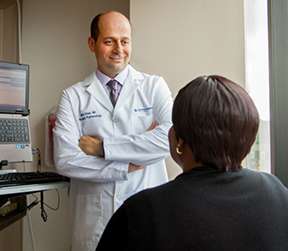Melhem Imad, MD
Interventional Pulmonology & Pulmonary/Critical Care, Bayview Physicians Group; Director of Interventional Pulmonology, Chesapeake Regional Medical Center

Too often, physicians have had few options to help patients with severe emphysema, who become increasingly frantic to breathe normally.
The alveoli in these patients’ lungs have deteriorated beyond the point that medications, inhalers or pulmonary rehabilitation can ease shortness of breath, coughing and wheezing. Many also don’t qualify for surgery such as a lung volume reduction or a lung transplant.
Thankfully, the FDA has approved two endobronchial valves as a minimally invasive option for some patients. In 2019, Dr. Melhem Imad began offering the procedure in Hampton Roads and, after a COVID-related pause, has resumed with promising early results.
“It’s very rewarding because this is a population that frequently gets written off as past the point of any recovery,” Dr. Imad says. “They are sick, debilitated and desperate to find something that can help them live more comfortably.”
During this 45 to 90-minute hospital procedure, endobronchial valves are placed in airways of the most damaged lobe(s) in emphysema lungs via a flexible bronchoscope or camera.
The one-way valves work by blocking damaged lung regions, closing during inhalation and opening during exhalation to release trapped air from the most inflated and least functional lobes. Freeing up room for the healthier lobes to expand and work better helps reduce pressure and hyperinflation inside the lungs.
Effectiveness does depend on the distribution of diseased tissue in the lungs. However, nearly half of patients experience at least a 15 percent improvement in lung function score, according to a multi-center study on the first valve approved by the FDA in 2018.
“With the severity of this disease, recovering even some of that lung functionality can have an enormous impact on quality of life,” Dr. Imad notes.
The valves are not an option for smokers or patients with an active lung infection, reduced heart function, allergies to certain implant materials, or other health factors that make them poor candidates for a bronchoscope procedure.
Interventional pulmonologists must complete a thorough assessment before proceeding. Patients also need to be hospitalized for three days of post-procedure monitoring due to a higher risk of pneumothorax during that time period.
Dr. Imad, an Interventional Pulmonologist and Pulmonary/Critical Care Physician, joined Bayview Physicians Group in 2007. A native of Lebanon, he came to America in 2001 for an Internship and Residency in Internal Medicine at Staten Island University Hospital. He also has completed two fellowships: Pulmonary & Critical Care at the University of Texas Medical Branch and Interventional Pulmonology at The Johns Hopkins University Hospital.
A leader at Chesapeake Regional Medical Center since 2016, Dr. Imad has led a push to improve treatments for multiple lung disorders, including the development of a thoracic multi-disciplinary clinic for lung cancer, nodules and masses.
Dr. Imad also helped the hospital acquire a Navigational Bronchoscopy System to examine and biopsy difficult-to-access areas of the lungs; a Bronchial Thermoplasty System to shrink smooth muscles that tighten during asthma attacks; and a Rigid Bronchoscopy set to relieve obstruction from tumors of the trachea and proximal bronchi and place stents to keep them open.
Additionally, he has trained physicians in endobronchial ultrasound and, as an Assistant Professor at Eastern Virginia Medical School, taught senior fellows to perform advanced bronchoscopy and other interventional procedures.
Adding the endobronchial valve procedure has been a welcome addition to Dr. Imad’s practice for his patients struggling with a dangerous and incapacitating form of chronic obstructive pulmonary disease.
“There’s a large need for this kind of option in our community,” he relates. “It’s actually heart-breaking if people find out they’re not a candidate. That alone tells you how important it is to look for ways to help them.”
Outstanding Achievements recognizes a local physician for accomplishments in the areas of education, medical innovations or introduction of new treatments and technologies to the region. It is our honor to recognize these accomplishments.
Please let us know if there is a physician who deserves recognition in this column. Email: holly@hrphysician.com

